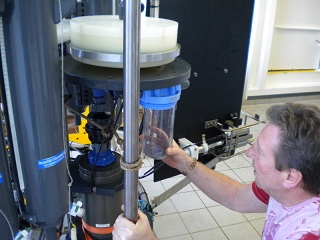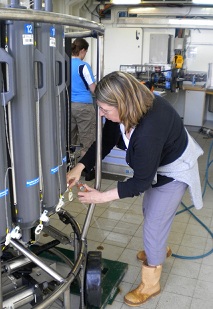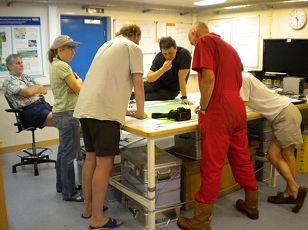Thursday 8th April
Today the CTD (Conductivity, Temperature and Depth) probe went twice to the bottom of the ocean, more than 4500 metres below us. We're also launching Autosub6000 on another mission, at Mount Dent (see 3rd April entry for our latest map of it). Meanwhile we've been trying to find out the source of Mount Dent's name - possibly named after a former Royal Navy Commodore in the Caribbean from the 18th century?
The two dips of the CTD today mean that the chemists are busy, filtering large volumes of water samples in the lab so that they can analyse the particles that they contain.
Catching up with Dave Teare, Sea Systems engineer, today we have a look at what's carried on the CTD. In addition to the collection bottles, we are using a SAP (Stand Alone Pump), which pumps water through a set of filters to collect particles when the CTD is near the seafloor. The CTD we are using is made of titanium - this is because we are measuring trace metals in the water, so using a stainless steel CTD would risk contaminating the samples.

The CTD is probably one of the most robust pieces of ocean-going instruments used by the scientists to investigate the deep seas. It collects data and water samples, at various depths, for a variety of purposes. For example: studying the physical structure of the ocean and its currents, the chemistry of the water, and filtering the tiniest organisms to investigate marine microbiology.

When the CTD is in action, the ship stays usually stays in the same location. Each deployment of the CTD takes about four hours, so there is a lot of time to plan the next stage of the expedition. After considerable thought, we made the decision yesterday to head for another area to deploy Autosub6000, this time leaving it alone for about 12 hours. Its mission will be to undertake a bathymetric survey (see yesterday for background on bathymetry) of Mount Dent.

Our expedition has been the first time at sea for marine biologist Diva, who graduated from the University of Southampton last year. Here are some of Diva's reflections on the experience so far:
'The whole experience has just been amazing and I am so grateful to Doug and all the other scientists for inviting me on board.'
'This trip has also made me realise that safety really is the number one priority when working at sea! Prior to joining the ship we all had a sea-going medical and attended a sea survival course.'
'When going out on deck we must wear the correct PPE (Personal Protection Equipment) for the operations that are going on. These are usually: hard-hat, overalls and safety boots. Sun-block is now also recommended PPE!'
'Waves cause the ship to roll and pitch, so the laptop you place on the desk will also roll and pitch off it... This can be prevented by bringing sufficient non-slip mats, eye-bolts, screws, tape, bungee cords and anything else that you think will secure your equipment.'
So as we head off to deploy Autosub6000 again, it's important to realise that science at sea is not always about the excitement of big discoveries, and that quiet days do happen too...


